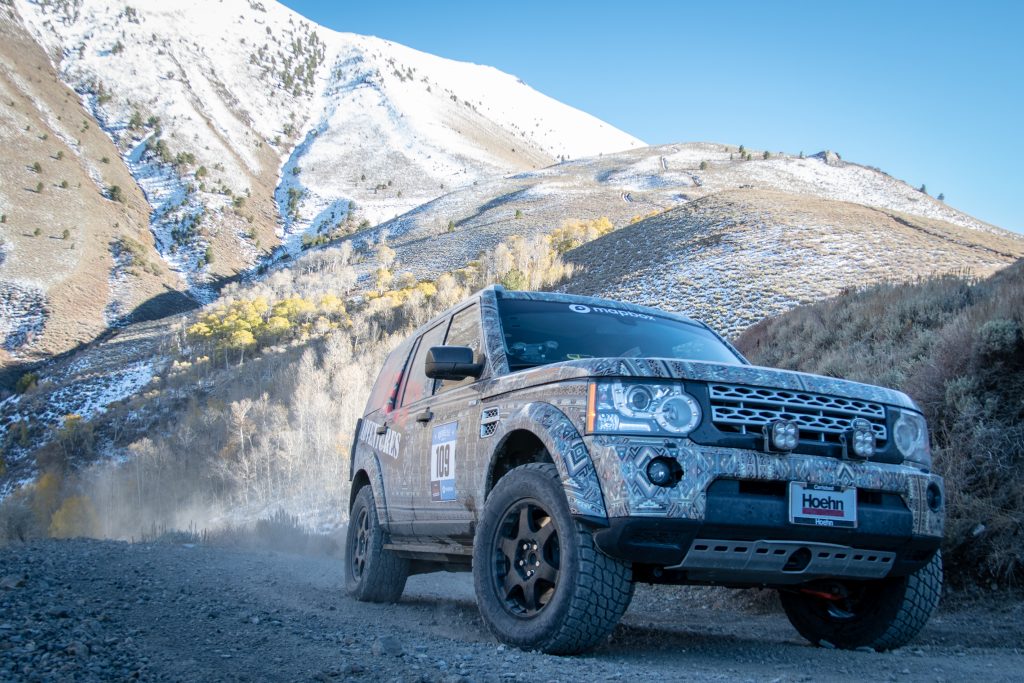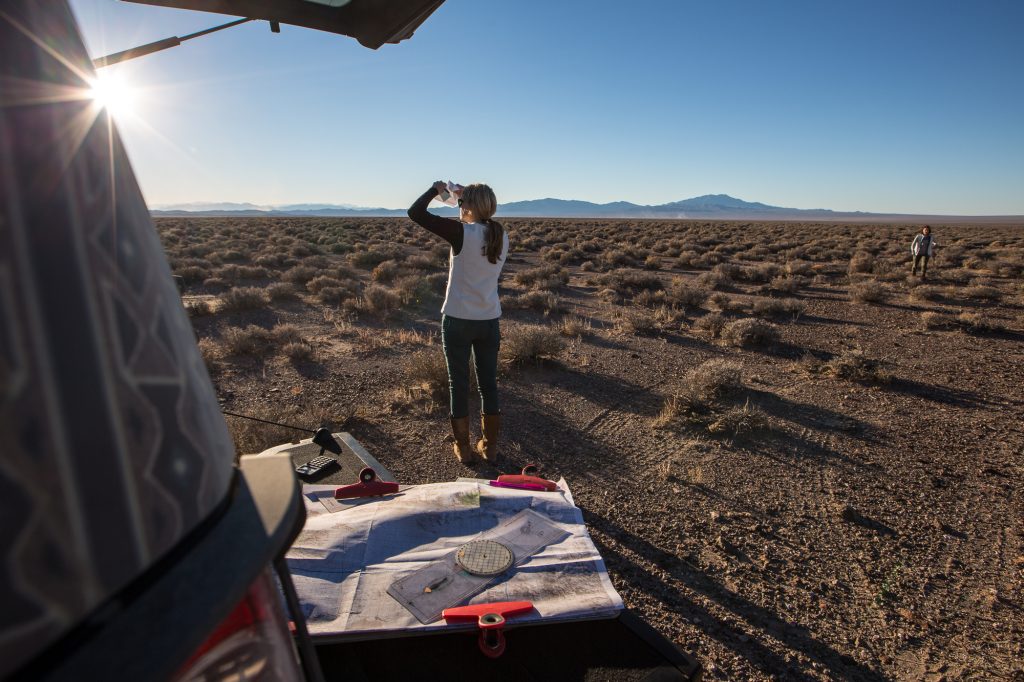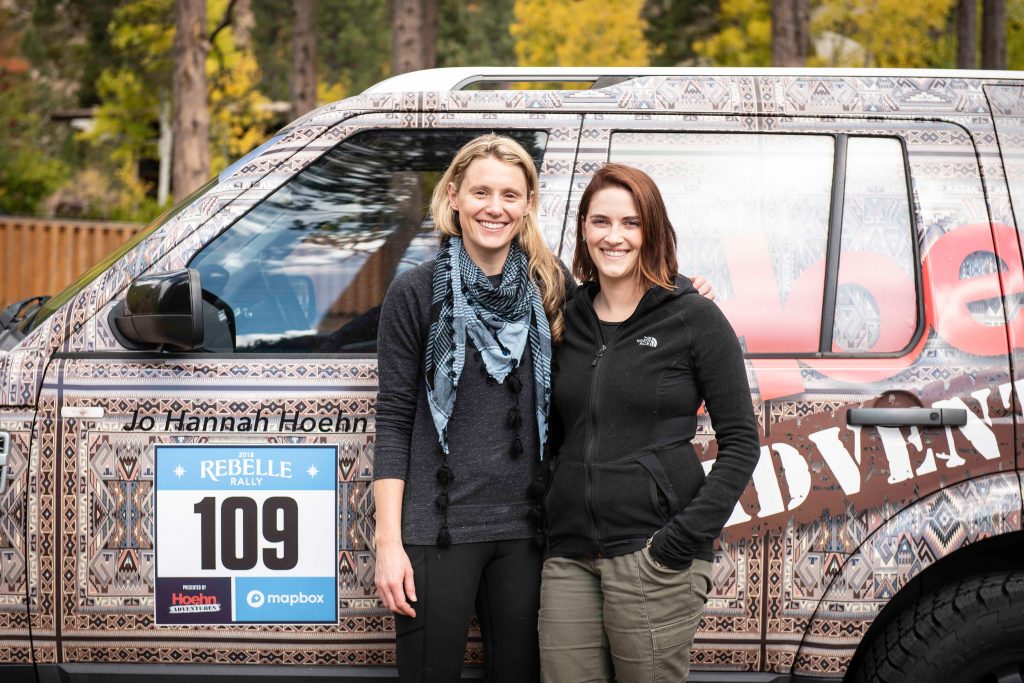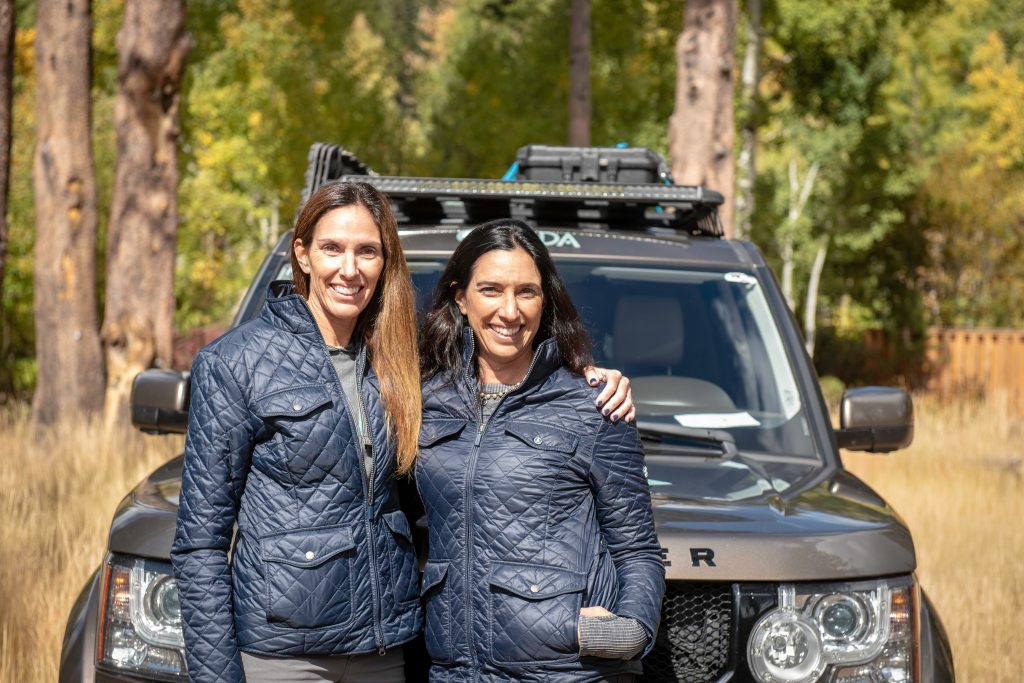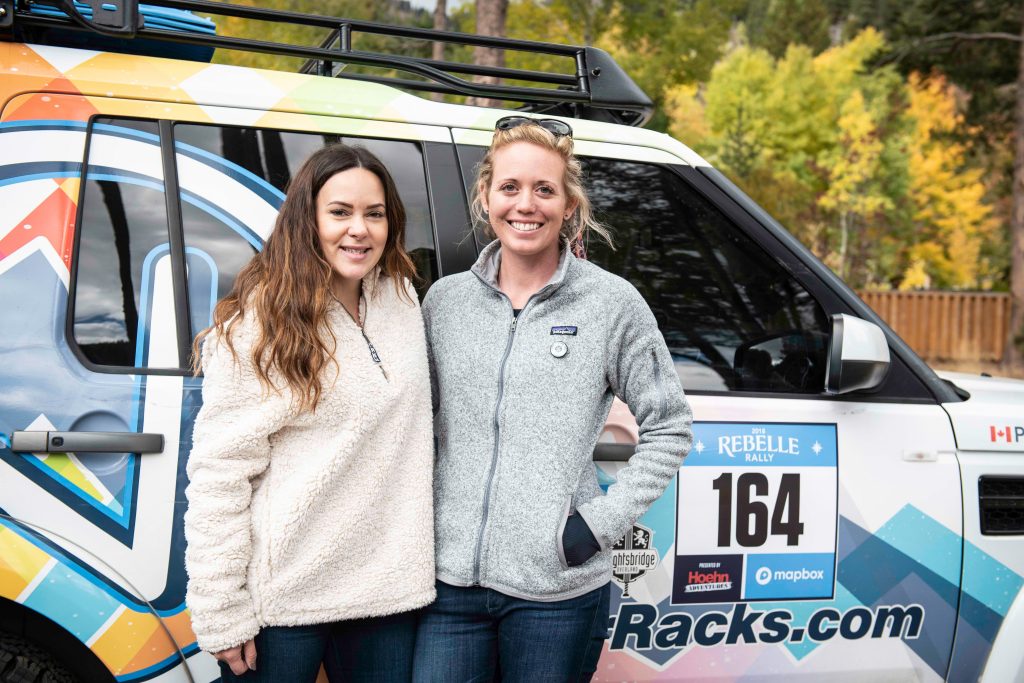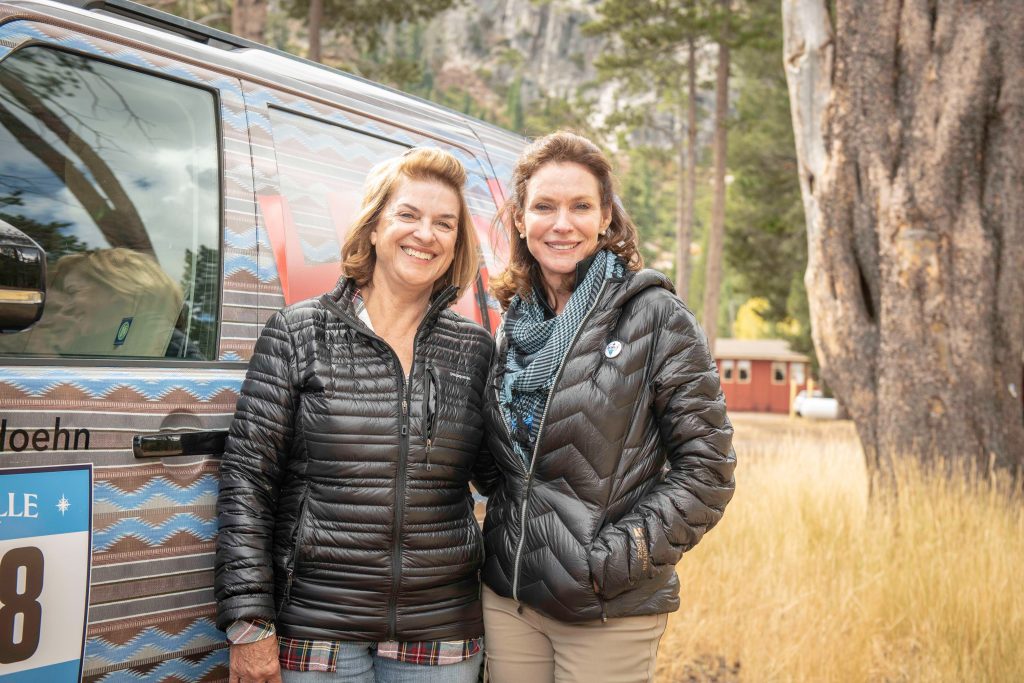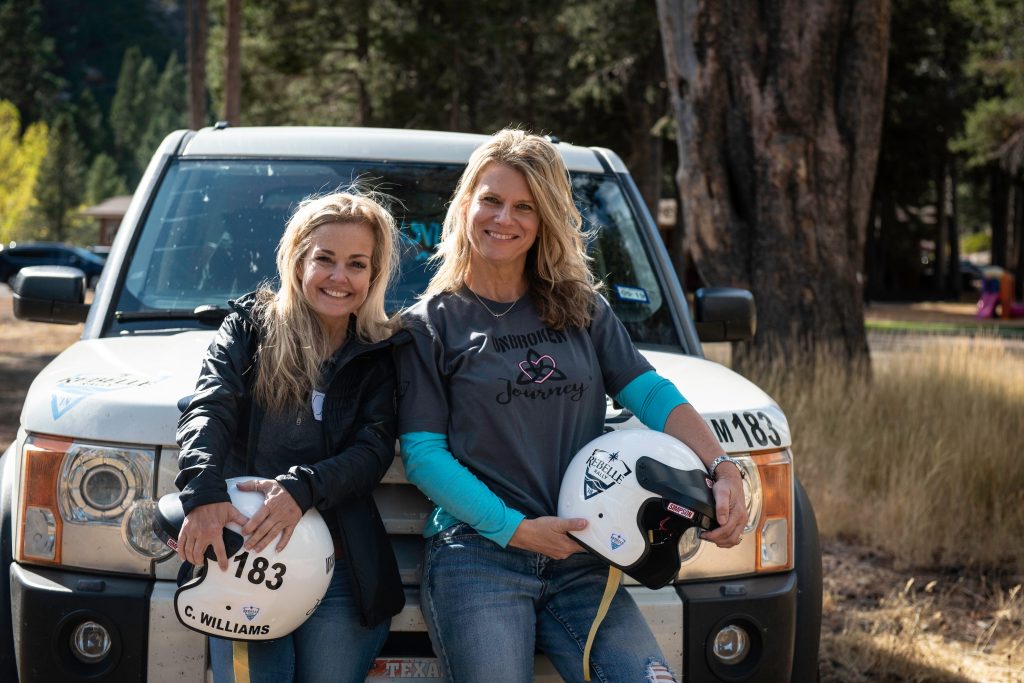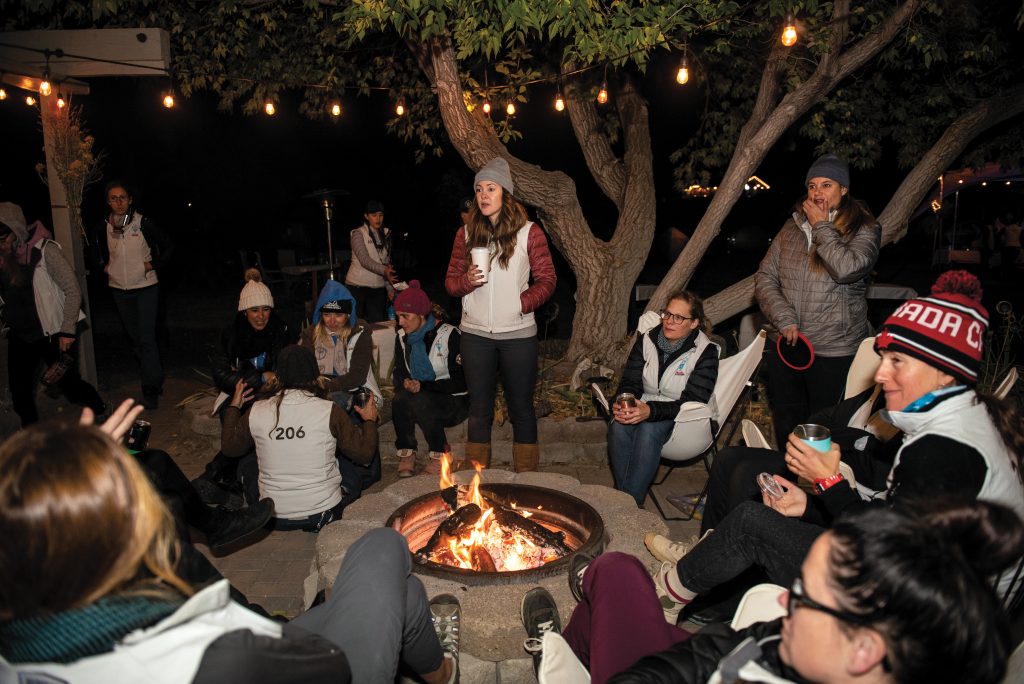Ten days total, eight off-road driving, and orienteering, no GPS or smartphones, only paper topographical maps and chart plotting tools, no advance notice of the daily route. Five a.m. wake-up calls, driving over unknown terrain, digging out, orienteering and navigating until nightfall. Setting up and breaking camp. Fuel up and check your vehicle. Repeat times eight.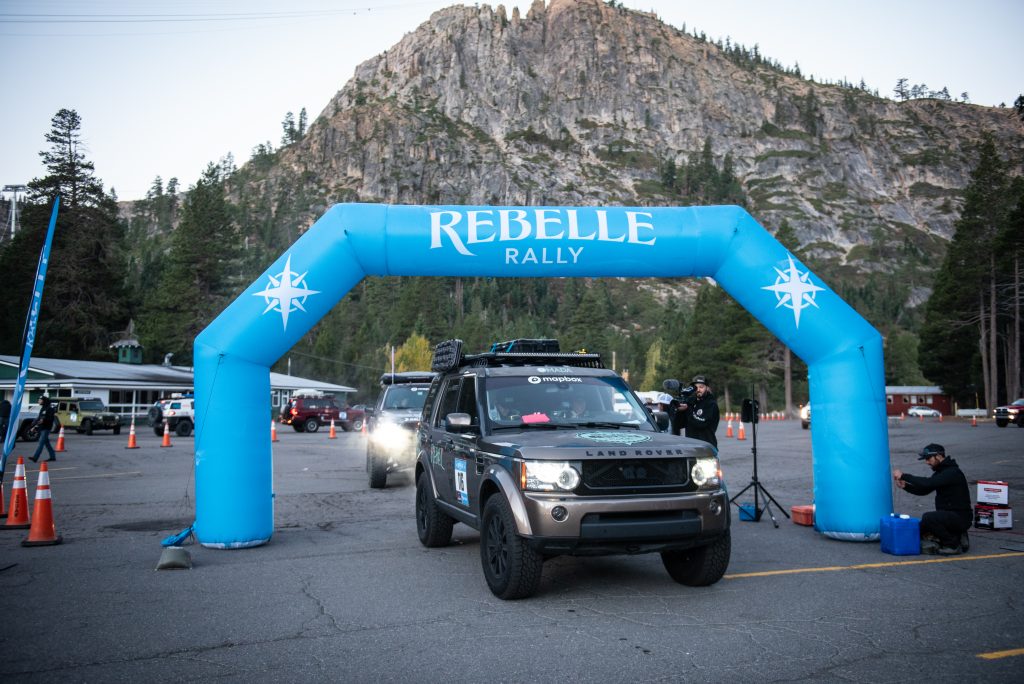
For 84 women — 42 teams from five countries and 17 states — this became the daily grind during last October’s Rebelle Rally. The event began at Squaw Valley, on the California side of Lake Tahoe, crossed through the high desert of Nevada and California and ended in San Diego. Five teams entered Land Rovers and all praised the experience.
The Start
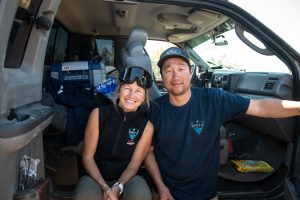 Emily Miller, the Rally’s founder, alerted everyone with, “This is not a watered down, painted pink women’s event! We’re here to create a world-class competition, one that’s fair, safe and professional.” One hundred fifty competitors, staff and media observers applauded in agreement.
Emily Miller, the Rally’s founder, alerted everyone with, “This is not a watered down, painted pink women’s event! We’re here to create a world-class competition, one that’s fair, safe and professional.” One hundred fifty competitors, staff and media observers applauded in agreement.
No more of Squaw Valley’s warm beds, hot showers, hotel bars, and shops. “Day Zero” served as a tech inspection and a “practice run.” Competitors received their maps, plotted their courses, and starting at 7:00 am, departed in sequence. Checkpoint scores achieved on this day wouldn’t count towards the Rally totals. For experienced Rebelles, this day became a tune-up. For novices like Channel Williams, San Antonio, TX and Marie Campbell, Bulverde, TX [Team Unbroken Journey, ‘05 LR3], the day “was terrible! We’re great friends and we had so enjoyed the beauty of the 1,700-mile drive to reach Squaw Valley. After the introductory classes and the practice day, we were overwhelmed with fear!”
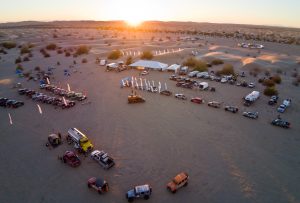 Every competitor received a numbered, white down vest. “It will start out clean and you will get it dirty, very dirty.” (There’s even a Dirty Vest award at the end of the competition.) Helmets must be worn all day, every day. You must fuel up using the fuel trucks that show up at every campsite. At a set time every night, your vehicle will sit in an impound zone. Your vehicle will have an emergency tracking device in case of a medical emergency or a disabling breakdown.”
Every competitor received a numbered, white down vest. “It will start out clean and you will get it dirty, very dirty.” (There’s even a Dirty Vest award at the end of the competition.) Helmets must be worn all day, every day. You must fuel up using the fuel trucks that show up at every campsite. At a set time every night, your vehicle will sit in an impound zone. Your vehicle will have an emergency tracking device in case of a medical emergency or a disabling breakdown.”
The Competition
Everyone had an adrenaline rush at the starting line which had to subside to focus on the day’s challenges. Veteran Rebelles knew the drill, but for novices, the first day felt tougher. Channel Williams remembered, “My medical problems that day made me think I should quit. But when we arrived at camp, other competitors emptied our Land Rover and set up our gear. We were prepared in terms of gear, but less in terms of our own emotional responses.”
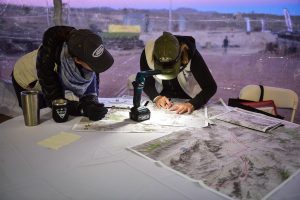 As night fell on Day 1, the entire group set up camp outside of Kingston, NV, population 113 and elevation, 6,140 feet. The organizers provided me with a tent, ground pad and a sleeping bag. The backpacker’s tent was the size of a coffin and resembled a sandbox every morning. The 20-degree temperatures overwhelmed the sleeping bag’s “three-season” ratings. The ground pad lost its battle with the rocks below. At 5:00 am, someone walked around clanging a cowbell like Will Ferrell.
As night fell on Day 1, the entire group set up camp outside of Kingston, NV, population 113 and elevation, 6,140 feet. The organizers provided me with a tent, ground pad and a sleeping bag. The backpacker’s tent was the size of a coffin and resembled a sandbox every morning. The 20-degree temperatures overwhelmed the sleeping bag’s “three-season” ratings. The ground pad lost its battle with the rocks below. At 5:00 am, someone walked around clanging a cowbell like Will Ferrell.
I unzipped my tent and stare at the holes in the ground, wondering which venomous creatures lived there. I stared out of an encampment of dome tents sheltering the competitors, staff and volunteers. They have two hours to break camp, pack their vehicles, plot that day’s route, attend a mandatory driver’s meeting, grab breakfast, pack a lunch, check out their vehicle and arrive at the start point at an exact time. This will be the daily routine for the next 8 days of competition. I’m in awe of them every morning.
At 5:30 am, each team receives that day’s topographical map with coordinates as to the location of checkpoints, rated by difficulty. Green flag checkpoints are marked by 8-foot high flags (but it’s uncanny how small they can look in the uneven terrain of the desert.) The next level of challenge elevates with the blue flag checkpoints as they’re much shorter and even less visible. The toughest ones are the black checkpoints; no flags at all, just a GPS coordinate that you must locate within a 50-meter radius. It’s up to the navigator to plot the best route that will enable the team to reach as many of the 15-22 daily checkpoints within a 10-hour window. It’s up to the driver to actually get there. The team is responsible for daily maintenance and repairs of their vehicles; engage the roving team mechanics and you lose points. While teams go analog for the 10 days, the Rally could be followed live online; Emily alerted everyone that “the world is watching.”
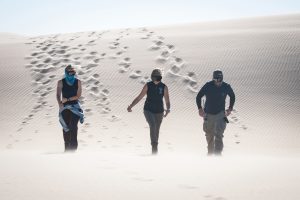 At the 6:00 am drivers’ meeting, Emily Miller reminded everyone, “The Rebelle is about setting the right personal goals. The Rally is all about how you compete, how you conduct yourself. Everyone will find a way to cross the finish line. In a world of talk and campaigns, you’re doing the real thing.” At 7:00 am, a luck of the draw determines the order of the departures, each one minute apart. You might not arrive back at a camp until sunset.
At the 6:00 am drivers’ meeting, Emily Miller reminded everyone, “The Rebelle is about setting the right personal goals. The Rally is all about how you compete, how you conduct yourself. Everyone will find a way to cross the finish line. In a world of talk and campaigns, you’re doing the real thing.” At 7:00 am, a luck of the draw determines the order of the departures, each one minute apart. You might not arrive back at a camp until sunset.
The Rebelle will require stamina, conviction and off-road and navigation skills — for 10 hours a day over 10 driving days. To Emily Miller, the core elements of the Rally are its “structure, distance, driving and navigation challenges, and duration. It’s Day 3 when everyone wants it to be over. If it were just a three-day competition, then when you’d had enough, you could go home. No, you need to dig down and confront quitting. You will make mistakes over the days. You have to work through them. That’s the nature of top endurance events. That’s what this is about.”
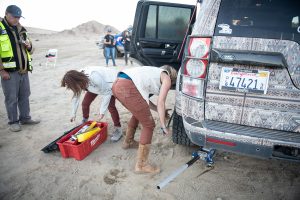 Just in case anyone gets overconfident, the Rally throws in a few “Enduros.” The requirements change from searching out checkpoints to the classic rally practice of taking to trails or roads (shared with the general public) through a rulebook that identifies each turn, distance and time. The navigator must communicate all this information to the driver, who in turn must make certain that she arrives at each checkpoint within a small window of time.
Just in case anyone gets overconfident, the Rally throws in a few “Enduros.” The requirements change from searching out checkpoints to the classic rally practice of taking to trails or roads (shared with the general public) through a rulebook that identifies each turn, distance and time. The navigator must communicate all this information to the driver, who in turn must make certain that she arrives at each checkpoint within a small window of time.
The Landscape
Over those days the teams would confront steep climbs up desert tracks or long stretches across dry salt beds — that turned sinking mud with the slightest rainfall. Mountains ringed them in the distances. You learned that what appeared as a flat plain, featured numerous hills, crevices, and mesas that hid checkpoints from view. The teams could drive for hours only to find that a minor navigation error took them far afield. Drivers had to be confident in their ability to read the trail surfaces and to know how to tackle the wide range of surfaces, from packed gravel trails to desert sand dunes.
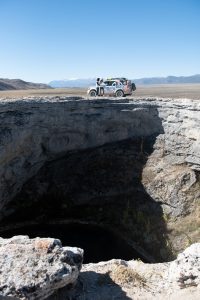 Each day revealed more evidence vastness of the Nevada desert. One day media handlers Clint and Lisa Scruggs, Colorado Springs, CO, had driven me to a ravine near a checkpoint. They’d been called away, but promised to return within an hour. I had my cameras, a notebook, and a cellphone with no reception. Under a bright sun, the temperature struggled to reach 60 and seemed to suck away any small amount of moisture in the air. The landscape featured fifty shades of brown. It was strewn with jagged rocks; none had smooth surfaces. I learned what a bed of nails must feel like. I kept a wary eye out for scorpions. But saw no other sign of wildlife. I waited and waited for a sign of a vehicle, scanning the vast horizon for a tiny cloud of dust. There was no sound but the rush of wind. I started to feel like James Franco in 127 Hours.
Each day revealed more evidence vastness of the Nevada desert. One day media handlers Clint and Lisa Scruggs, Colorado Springs, CO, had driven me to a ravine near a checkpoint. They’d been called away, but promised to return within an hour. I had my cameras, a notebook, and a cellphone with no reception. Under a bright sun, the temperature struggled to reach 60 and seemed to suck away any small amount of moisture in the air. The landscape featured fifty shades of brown. It was strewn with jagged rocks; none had smooth surfaces. I learned what a bed of nails must feel like. I kept a wary eye out for scorpions. But saw no other sign of wildlife. I waited and waited for a sign of a vehicle, scanning the vast horizon for a tiny cloud of dust. There was no sound but the rush of wind. I started to feel like James Franco in 127 Hours.
Over the next several days I learned that the topography varies dramatically. The hilly trails used on the Enduros provide spectacular views of canyons formed eons ago. To stand on the edge of a cliff and see scrub brush or pines clinging to a vertical face gave you a new appreciation for the work of the federal Bureau of Land Management. The BLM has tight regulations to enforce “Tread Lightly” and the Rebelle supports and adheres to them. My jaw hurt from gawking at the extraordinary landscape.
We would pass through the ruins of Goldfield, NV, once a city of 30,000 and now a ghost town, after making camp at Diamondfield Gulch, with a surprise of a small saloon and Fred, the resident donkey. The hardscrabble grounds of Diamondfield would give way to the near-oasis at the China Ranch Date Farm in Tecopa, CA. Competitors would also find that, unlike previous days in which surprisingly tasty breakfasts and dinners were prepared for them, two “Marathon Stages” would demand they make camp, cook their own meals, break camp and then travel to the next campsite and repeat the day.
The teams moved westward into the high desert of Johnson Valley, CA, north of the San Gabriel Mountains. Some of the checkpoints lay in the same rocky hills and dry lake beds as the famous off-road “King of the Hammers” race. From the rock-strewn high desert, the teams neared the finish line but first had to tackle the Glamis Sand Dunes in Imperial County, CA. The soft sand tripped up many teams and provided the final challenge before emerging from the dunes and into the urban comfort of San Diego.
The Competitors
Jeep, Porsche, Ram, Nissan, and Honda provided vehicles for competitors; five of the 42 teams ran their own Land Rovers.
Team Hoehn Adventures, #109
Jo Hannah Hoehn and Susie Saxten, (Team Hoehn Adventures), both of San Diego, CA, came in 4th place in a ’12 LR4. Only 10 points separated them from first place and Jo Hannah remembered where they likely lost points. They’ve run the Rebelle each year, and they’re off again this March to the Rallye Aicha des Gazelles in Morocco.
Team Omada Adventure, #116
Deborah Najm, Orange, CA and her sister Laurie Mellott, Ladera Ranch, CA, (Team Omada Adventure) finished 17th — only one point out of 16th — in Deborah’s ’12 LR4. It’s her third Rebelle, but Laurie’s first, so Deborah was aware of the need to step back and let her navigator take responsibility. She also sought to temper her disappointment at missing a checkpoint, “not letting it weigh on me.”
Deborah reflected, “Every rally has been different. I feel like I became a better person each time. Running the event holds up a mirror to yourself. I’m a competitive swimmer, an individual sport, but this is a team effort.”
For Laurie, a clinical medical research director, “This was the hardest thing I’ve ever done — and that was my feeling on Day 1! It’s a different type of challenge. Sometimes you can just muscle through things, but this is quite cerebral a mental endurance challenge. The Land Rover was amazing. It’s bone stock, too.”
Team Aman Cara, #164
Thayer Cook, Arvada, CO and Penny Dale, Vancouver, BC (Team Aman Cara) agree that Thayer’s ’13 LR4 became the vital third member of the team. Thayer said, “My biggest worry was the air suspension. I nose-dived into harder sand and broke a wire that would not permit the air suspension to rise. I had to call for the Rally chief mechanic, Nick Cimmarusti, for help. It cost us 50 points, but Nick repaired the break on the field. Now I know better!”
“The real challenges of the Rally lay in the navigation and the endurance required. There was no time to rest up. We never took lunch as it felt like you had no time. I tried to get enough sleep as that wears on you as much as the driving. Setting and breaking camp every two days was a pain. A wind storm in Glamis blew our tent over. Months later, I’m still finding sand in my gear!”
Navigator Penny Dale remembered, “The first day, I seemed to forget everything. I’m the navigator and it’s all on me. One competitor offered to help me, reminding me how to complete a task, and that would happen almost every day. Women competitors would constantly build each other up. I never expected that it would be that supportive. Women in business often talk about it but don’t actually help each other. “Monty,” our LR4, was amazing!”
Team Hoehn Adventures, #108
Karen Hoehn, Del Mar, CA and Dana Saxten, Encinitas, CA, each veteran Rebelles, (Team Hoehn Adventures) found their LR4 the perfect vehicle for the event. Their daughters piloted and navigated the other Hoehn Adventure Team. Karen has been an enthusiastic supporter of the Rebelle and her company was also a corporate sponsor. Their 17th place finish came about because of problems on just two days, demonstrating the focus and endurance required of driver and navigator.
Team Unbroken Journey, #183
For Channel Williams and Marie Campbell (Team Unbroken Journey), their entry was an in-your-face assault on Channel’s bout with cancer. Their LR3 picked up many signatures from participants affected by cancer in their families. Their 35th place finish showed their commitment to pushing harder every day.
Channel reflected, “Our team was a total testament to Emily Miller’s vision. When it was over, it was difficult to come back to the real world. We both felt such a change in perspective. It was very hard and scary, but beautiful and with so much personal growth. Everyone should do it!”
[We asked Rovers Magazine correspondent and Rebelle Rally competitor Mercedes Lilienthal (Team Free Range Dames) to reflect upon her experience -ed.]
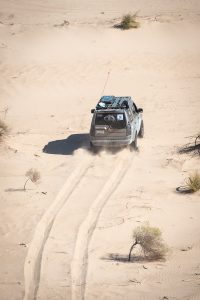 My favorite part about running the Rebelle is the community. The Rebelle is about competence, confidence, and comradery. It’s a highly communicative, focused, and helpful atmosphere. No matter what team you are part of, people are there to help you. And, in turn, you are there to help them. It is an unexpected playground of teachable moments.
My favorite part about running the Rebelle is the community. The Rebelle is about competence, confidence, and comradery. It’s a highly communicative, focused, and helpful atmosphere. No matter what team you are part of, people are there to help you. And, in turn, you are there to help them. It is an unexpected playground of teachable moments.
The Rebelle Rally taught me many things about myself, my relationships of those around me, as well as the vehicle I drove (a 2012 Toyota TRD Tacoma). I had ample opportunity to practice mechanical sympathy with the rig, letting myself create a symbiotic relationship with it. Although the truck wasn’t mine (it belonged to my navigator’s husband), I learned where its happy points were, where its power band was, how it braked, and how fast it accelerated and cornered.
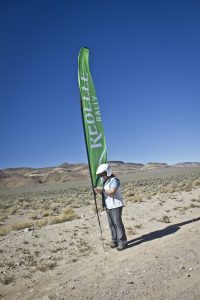
The Rebelle is unlike anything I’ve ever done before. I drove through terrain that incorporated big mountains, thick forests, sand dunes taller than your house, water crossings, and washes up the wazoo. Also witnessed were miles and miles of high desert, ascents and descents, steep rock, and off-camber conditions — all within the competition’s confines. It’s an off-roader’s paradise.
The Rebelle throws a lot of curve balls at you. You think you knew where you are, only you aren’t at all where you thought. You’re positive you can traverse a tricky sand dune and you end up buried to your frame. You hear new groans and chirps while you traverse the 1,600-mile route — hoping that nothing is wrong with your 4WD-wheeled chariot! You breathe deeply, take a moment to re-center yourself and carry on.
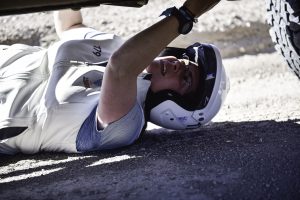 The Rebelle Rally, as well as nature, create an off-road puzzle in which only the determined and clever will navigate successfully. Some days were my best, and some days were exceedingly challenging. As a driver, I experienced every type of emotion: elation, defeat, as well as everything in between. I learned a lot about myself as I experienced those emotions. I also learned about my skill levels, especially regarding my driving ability. The soft sands of the Rebelle were a different animal than the hard-packed coastal dunes we have along the Oregon Coast. I learned the heat of the day makes the California sand super soft and more difficult to traverse through than when it’s early or late. Certain times of the day played a major role, too. Mid-day posed the greatest challenge for traversing; the sun high up in the sky with rays that seduced you with stark contrasts against earth’s canvas.
The Rebelle Rally, as well as nature, create an off-road puzzle in which only the determined and clever will navigate successfully. Some days were my best, and some days were exceedingly challenging. As a driver, I experienced every type of emotion: elation, defeat, as well as everything in between. I learned a lot about myself as I experienced those emotions. I also learned about my skill levels, especially regarding my driving ability. The soft sands of the Rebelle were a different animal than the hard-packed coastal dunes we have along the Oregon Coast. I learned the heat of the day makes the California sand super soft and more difficult to traverse through than when it’s early or late. Certain times of the day played a major role, too. Mid-day posed the greatest challenge for traversing; the sun high up in the sky with rays that seduced you with stark contrasts against earth’s canvas.
During the Rebelle, my senses awoke with acute abilities: to see, hear, smell, and notice small differences. All the while, I could have missed the easiest turn, terrain change, or checkpoint. It was a real-life game of off-road chess. Team Free Range Dames placed in the top third of the Novice Class, and within the top half of the 4×4 Class. We’re looking forward to 2019!
[For information on the 2019 Rebelle visit http://www.rebellerally.com]
